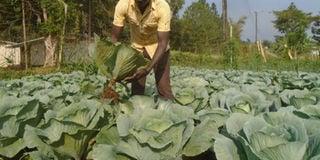Dos and don’ts of cabbage farming

Jafar Abubaker picks his money from cabbages. Photo by Fred Muzaale
A cabbage is a leafy blue, red (purple), or green (depending on the variety) plant grown as an annual vegetable crop for its dense-leaved heads.
Cabbage is high in nutritional value. It is among the high value crops, which when grown have high returns. Because they are quick maturing (three months), a farmer is able to get money in a short time.
However, before a farmer thinks of growing cabbages, he/she should consider getting the seeds from a genuine seed dealers as many traders sell fake seeds.
Jafar Abubakar, a lecture at Bukalasa Agricultural College in Luweero District, stresses that for high yields, a farmer must buy quality seeds, although they are relatively expensive.
Varieties
There are a number of cabbage varieties grown in Uganda which include, Escazu, Drum head, Gloria F1 and Copenhagen varieties.
However, Gloria F1, which is a hybrid variety is the most liked by farmers and on the market because it has a compact head, it has a longer-shelf life, and it is sizeable and tolerant to bacterial rot.
Soils
Cabbage prefer well drained, fertile soils high in organic matter, and with a PH between 6.0 and 7.5. They can however tolerate slightly alkaline soil. Cabbages are heavy feeders and as such they need plenty and consistent moisture.
Planting
Jafar says a farmer should first plant his/her seeds in a nursery bed. The bed can either be the raised or the type where the seeds are planted in pots.
The soil for the nursery bed should be first sterilised to kill pests of plant cultures such as weeds, bacteria, fungi and viruses before seeds are planted.
A farmer can use dry grass which is placed on the raised soil for the nursery and then burnt.
“After sterilising, the soil should be left for at least seven hours to cool after which furrows are made in the soil. Then place seeds in the furrows which should be twice the size of the seeds,” Jafar says.
Mulching
Afterwards, the bed should be mulched with grass to reduce evaporation of moisture and to maintain darkness for easy germination of the seeds.
Also, construct a shed over the bed and water at least once a day, depending on the weather.
Spraying, transplanting
The seedlings should be sprayed with fungicides and pesticides once in three days, depending on the occurrence.
After three to four weeks, the seedlings are ready for transplanting to the main garden.
However, Jafar says transplanting should be done early in the morning or in the evening to reduce on the stress on the plant.
The soil in the main garden should be affirm soil to keep the cabbage roots anchored because cabbage heads are heavy.
It should be noted that before the seedling is planted in the hole, small amounts of DAP fertiliser should be put in it. The fertiliser is then covered with some soil before the seedling is planted. This fertiliser helps the crop to develop strong roots.
“After three weeks, a farmer should apply foliar fertiliser such as Rapid Grow which is rich in Nitrogen. This makes the cabbage to be healthy,” says Jafar.
Cleanliness
It should be noted, however, that cleanliness in the garden should be maintained as this prevents pests and diseases from attacking the crop. Hence, the farmer will reduce on the cost of buying pesticides. After two and half months, the cabbages are ready for harvesting.
In an acre, there can be 10,000 cabbages of Gloria F1 variety. This means that if the farmer gets a good market where he sells at Shs1,000 per head, he earns Shs10m.
Jafar advises that for a farmer to get high profits he should target times when other farmers are not planting the vegetable. This can be done by planting during droughts and the farmer irrigates his crop.
Tips
Excessive application of nitrogen alone results in loose puffy heads, which cannot be stored for a long time.
Cabbage is shallow-rooted and care should be taken not to damage roots in the field as this would encourage entry of fungi and
Cabbage is also a poor competitor of weeds thus it should be protected. Avoid excessive weeding. This may lower yields due to excessive water loss.
Mulching may be beneficial in weed control and conservation of soil moisture.
Irrigation should be done whenever necessary.




